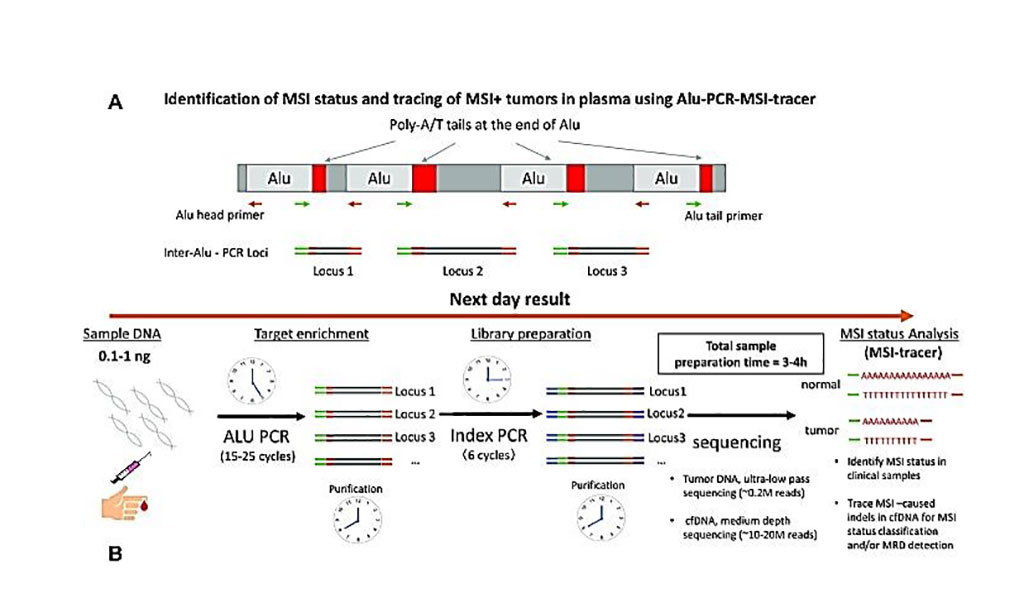PCR Method Identifies Microsatellite Instability in Tumor-Derived Samples
By LabMedica International staff writers
Posted on 31 Mar 2021
Sensitive detection of microsatellite instability (MSI) in tissue or liquid biopsies using next generation sequencing (NGS) has growing prognostic and predictive applications in cancer. However, the complexities of NGS make it cumbersome as compared to established multiplex-PCR detection of MSI.Posted on 31 Mar 2021
Tumors with MSI accumulate high numbers of somatic microsatellite (MS) insertions or deletions (indels), due to a loss of normal mismatch repair (MMR) ability. High levels of MSI are predictive for colorectal cancer (CRC) therapy outcome in chemotherapy and immunotherapy and has been associated with distinct characteristics and favorable results including better prognosis, a higher 5-year survival, and lesser metastasis.

Image: Schematic diagram for the identification of MSI status and tracing MSI+ tumors in plasma using Alu-PCR-MSI tracer (Photo courtesy of Dana-Farber Cancer Institute)
Radiation Oncologists at the Dana-Farber Cancer Institute (Boston, MA, USA) and their colleagues obtained snap-frozen colon adenocarcinoma stage II/III and paired normal tissue biopsies from treatment-naïve patients were obtained from the Massachusetts General Hospital Tumor Bank and gDNA was extracted using the Blood and Tissue kit (Qiagen, Hilden, Germany). Plasma was acquired from healthy volunteers and from stage I/II colon adenocarcinoma treatment-naïve patients. cfDNA was isolated using Qiagen’s QIAamp Circulating Nucleic Acids Kit. The concentration of isolated DNA was quantified on a Qubit 3.0 fluorometer using dsDNA HS assay kit (Thermo Fisher Scientific, Waltham, MA, USA).
To detect MSI the team developed a method called inter-Alu-PCR followed by targeted NGS that combines the practical advantages of multiplexed-PCR with the breadth of information provided by NGS. Inter-Alu-PCR employs poly-adenine repeats of variable length present in every Alu element and provides a massively-parallel, rapid approach to capture poly-A-rich genomic fractions within short 80–150bp amplicons generated from adjacent Alu-sequences. A custom-made software analysis tool, MSI-tracer, enables Alu-associated MSI detection from tissue biopsies or MSI-tracing at low-levels in circulating-DNA.
To establish the method's limit of detection in tissue samples, the scientists tested multiple scenarios using serial dilutions of MSI-H tumor DNA from colon cancer into matched normal DNA. The team used droplet digital PCR to validate the dilution approach using tumor-specific somatic mutations such as KRAS for a subset of the mutations. When a paired normal sample was not present, the team found that that the method had a limit of detection of 0.15% to 0.5% percent for somatic indels using a low-tumor purity clinical sample. When matched normal tissue was available, inter-Alu-PCR had a somatic limit of detection between 0.05% to 0.5%.
The team also showed how inter-Alu-PCR could be potentially used to detect MSI-related poly-adenine deletions in cell-free DNA (cfDNA) from a patient's blood sample. Analyzing cfDNA from colon cancer patients and healthy samples, they saw that MSI-H patients produced a higher MSI-Tracer score compared to MSS or normal samples. Overall, the study authors found that inter-Alu-PCR could classify MSI using as low as 0.1 ng of input DNA from a patient's blood sample.
The authors concluded that the combined practical and informational advantages of inter-Alu-PCR make it a powerful and practical tool for identifying tissue MSI-status or tracing MSI-associated indels in liquid biopsies using minute amounts of starting material. The study was published on February 26, 2021 in the journal Nucleic Acids Research.
Related Links:
Dana-Farber Cancer Institute
Qiagen
Thermo Fisher Scientific














